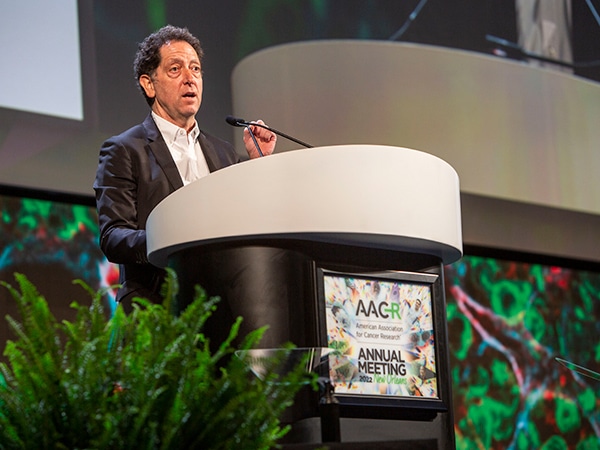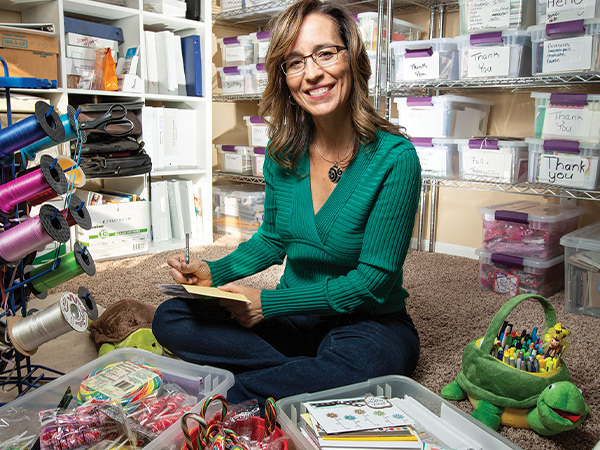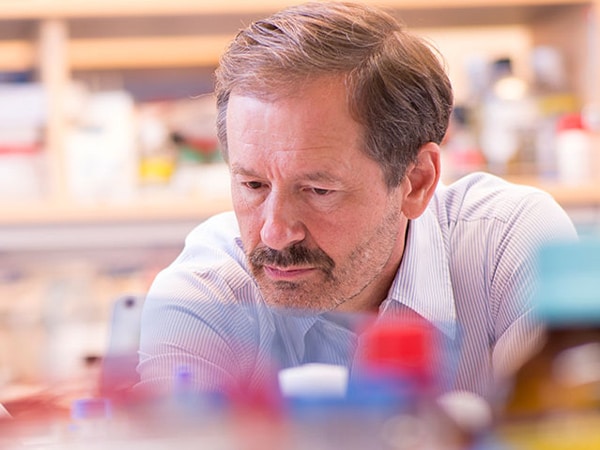Kevan M. Shokat, PhD: Drugging the Elusive KRAS
Dr. Shokat shifted the paradigm of targeted cancer therapy by drugging an “undruggable” protein and paving the way for future advances.
Kevan M. Shokat, PhD, was only 18 when researchers discovered the first family of cancer-causing genes, which included the notorious KRAS, mutated in up to 30 percent of all human cancers. He was a graduate student when scientists first learned how KRAS works and a postdoctoral fellow when the protein was deemed undruggable.
Almost 30 years later, during the AACR Annual Meeting 2022, Dr. Shokat was awarded the AACR Award for Outstanding Achievement in Chemistry in Cancer Research for spearheading a solution to the seemingly unsolvable puzzle. As a professor in the department of Cellular and Molecular Pharmacology at the University of California San Francisco, a professor in the Department of Chemistry at the University of California Berkeley, and a Howard Hughes Medical Institute investigator, he helped to discover a hidden pocket in KRAS, identify candidate drugs that fit the pocket, conduct clinical trials, and secure the approval of sotorasib (Lumakras) by the U.S. Food and Drug Administration (FDA) in May 2021.
By shattering the boundary between possible and impossible, these advances have heralded an explosion of research into other hard-to-target proteins.
“I thought that would be the 10-year plan, but it’s here already,” Dr. Shokat said.
While he has maintained a longstanding interest in the chemistry of biological compounds, cracking the elusive KRAS was not his original focus. For many years, he studied kinases—a family of signaling molecules, often mutated in cancers, that pass information from the cell surface to the nucleus.
“We didn’t pick one tissue type or one particular gene,” Dr. Shokat said. “Signaling molecules are mutated across all cancers, so we follow the protein wherever it takes us.”
One problem his team encountered was that the grooves and pockets where drugs bind to a protein’s surface were often remarkably similar between related kinases. This created significant challenges for researchers to design molecules that could block the function of one kinase but spare another. Instead, Dr. Shokat and his team studied what molecular quirks a cancer-causing mutation might introduce into a kinase, and which drugs might use those quirks to bind exclusively to the mutated protein.
“But a whole group of patients didn’t have kinase mutations,” he recalled. “They had mutations in KRAS, and we didn’t have any starting point for that.”
Unlike the kinases Dr. Shokat was used to, the surface of KRAS was relatively smooth, with only one notable binding pocket. Unfortunately, that pocket bound so tightly to KRAS’s natural target, GTP, that no drug could outcompete it. It was a puzzle that scientists had tried to solve for years, but when Dr. Shokat arrived on the scene, he brought with him decades of experience tackling similar quandaries in kinases.
A particular KRAS mutation, called G12C, caught his attention because the mutation introduced an amino acid that interacts particularly well with drugs.

“Whenever chemists see a cysteine, regardless of what the protein looks like, there’s a chemical opportunity to make an irreversible bond to the target,” Dr. Shokat said during a special session dedicated to the history of KRAS, held during the AACR Annual Meeting 2022.
In his talk, Dr. Shokat recalled how he and his colleagues screened a library of drugs to see how well they interacted with G12C. Those that stuck were wedged in a binding pocket that scientists hadn’t previously noticed—a pocket that only existed when the protein was turned off. If a drug could lodge in the pocket to prevent KRAS from turning on, it might prove effective against tumors harboring the mutation.
Dr. Shokat and his team selected a candidate drug, made some modifications to improve its fit and its ability to work in living organisms, and tested it in clinical trials. That drug became known as sotorasib, the first KRAS-targeting compound to be approved by the FDA.
The approval was rendered for patients with non-small cell lung cancer, the most common type of cancer driven by KRAS G12C, but Dr. Shokat doesn’t plan to stop there. Driven by the success of sotorasib, he and countless other scientists are now working to develop drugs for other KRAS mutations, such as G12D and G12V, common in colorectal and pancreatic cancer.
“There’s easily 2,000 scientists around the world working on this nonstop,” he said. “It’s amazing.”
While Dr. Shokat was honored to join the ranks of other “really amazing, outstanding achievers” who have previously won the Chemistry in Cancer Research award, he was especially thrilled that the story of sotorasib could exemplify how molecular research can shape clinical cancer care.
“We need those fundamental discoveries to understand basic cell biology, basic tissue biology, and basic developmental biology, because tumors use all of that,” he said.
The long process of trial and error required to develop a KRAS inhibitor, Dr. Shokat explained, also highlights how biomedical research is rarely as straightforward as it seems. “I think the public thinks science is a very linear thing,” he said. “When you tell the story at the end, you don’t talk about all the dead ends and cliffs you avoided, but that part is really so important.”
Dr. Shokat praised the AACR for creating an environment where scientists working through their own dead ends could come together and share information that may spark new insights.
“The meetings and the journals bring people together at the right time to condense things,” he said. “It keeps us moving forward and not scattered or overly competitive. Science is very competitive, but when you come to the AACR Annual Meeting, you get the feeling that everybody is here for the patient, looking for the answer and asking each other hard questions.”
Between making the scientific discoveries, developing them into potential therapies, and getting them to patients who need them, doing the impossible takes a village, Dr. Shokat emphasized.
“It takes the continuum from the university to the small companies to the big companies,” he said. “Participation in clinical trials is so essential to understanding the drug and benefiting patients who don’t have another option. At that point, it really needs the patient advocates.
“So many people contribute to the responses of the patients,” he continued. “At AACR, you see all those people get together, and I think that’s really, really powerful.”

